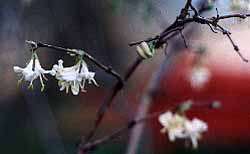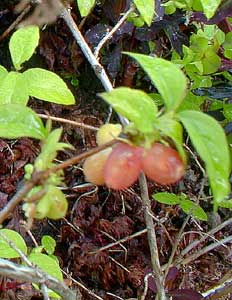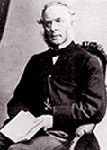
Winter Honeysuckle
aka: Fragrant Honeysuckle,
Sweet Breath of Spring, or
January Jasmine
"The seasons have just drifted by,
many moons have graced the sky,
whilst winter's honeysuckle bloom
has filled the air with sweet perfume."
-Joyce Hemsley
Sunderland,
England
Sunderland,
England
Winter Honeysuckle (Lonicera fragrantissima) is in full white blossom no later than the first week of February. The species name alludes to the unusually sweet lemony odor of the blossoms. The genus name is after Frankfurt naturalist, alchemist, physician, & author of a famous 1578 text on herbs, Adam Lonitzer (1528-1586). The honor was bestowed on him by Swedish botanist Carolus (or Carl) Linnaeus (1701-1778).

 Plant hunter Robert Fortune brought this species back to Great Britain from eastern China in 1845. Fortune is shown in the portrait at the right. We have many plants in our gardens associated with his plant hunts throughout Asia. Examples include Japanese Hollyfern (Certomium fortunei), Wintercreeper (Euonymous fortunei), Japanese Anemone (A. hupehensis var japonica), among others.
Plant hunter Robert Fortune brought this species back to Great Britain from eastern China in 1845. Fortune is shown in the portrait at the right. We have many plants in our gardens associated with his plant hunts throughout Asia. Examples include Japanese Hollyfern (Certomium fortunei), Wintercreeper (Euonymous fortunei), Japanese Anemone (A. hupehensis var japonica), among others.The dangling white flowers of the woody shrub are extremely pleasant smelling, & though they are humble blooms compared to the more familiar vining honeysuckles, the fact that they are blooming creamy-white with pink blush starting late in winter before there are leaves on the branches makes the white flowers rather showy for that time of year. Leaves follow fast on the heals of the full bloom, emerging yellow-green & slowly darkening to blue-green. The blooms & leaves are only momentarily to be seen together.
Budded branches can be brought in for winter bouquets, & will open indoors. Sometimes the timing will work out to force the buds to bloom indoors simultaneously with branches taken from yellow Forsythia.
Not only does this shrub re-leaf early following blossom, but it also holds onto those leaves long into autumn, one of the last deciduous shrubs to let go of its greenery. Indeed, winter honeysuckle is partially evergreen further south, but here in the Pacific Northwest it tends to be entirely deciduous. However, even in our temperate zone, the leaves do last unchanged until mid-January or so, so it nearly passes for an evergreen for the entirety of autumn & through much of winter. But eventually the leaves do drop, prior to flowering, & this is a preferred behavior since the smallish dangling flowers would not be nearly so overt if they were hidden amidst foliage.
The April portrait of the berries shows the fruit in their initial green ripening to pink. For May & June these are bright red berries, but become increasingly hidden under the bristle-tipped blue-green leaves once those are completely fluffed out. Many of the berries occur as conjoined pairs, looking like little breasts.
Full sun is best, but it will do fine in partial shade. It does not like too wet a soil, preferring loamy moist well-drained ground. It will grow to 8 feet height, occasionally ten, with equal width, having a twiggy irregular growth habit.
It will in most cases need one annual pruning to keep it from becoming too lanky, though its first two or three years it might not yet be so big as to demand pruning. Pruning is only for shape, or to keep it from spreading too wide. When pruning, keep in mind it blooms best on older limbs, plus its older wood has interesting exfoliating bark, so save as much old wood as possible. Pruning can be done almost any time after flowering.
Though it is not usually aggressive & is fairly restrained in the Pacific Northwest, it is regarded as an invasive pest in Tennessee, & has escaped from gardens in a few southeastern states.